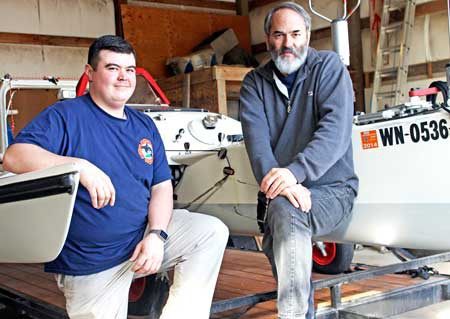With its squalls, hypothermia-inducing waters and 20-mile-an-hour rapid-like currents, the inside passage to Alaska is an engine-less sailors’ biggest challenge.
The first-ever “Race to Alaska,” brainchild of the Northwest Maritime Marine Center, is a 750-nautical-mile journey that begins June 4, from Port Townsend to Ketchikan, Alaska, with a grand prize of $10,000. The only catch is it must be done on an entirely engine-less vessel, human or sail powered.
Local sailor Nick Wainwright, 28, of San Juan Island, is one of the Race to Alaska hopefuls, on a very unique boat.
“It wasn’t even a question of should I do this race,” Wainwright said. “I have to. This boat is unlike anything else.”
The boat, named Microship, is an amphibious pedal and sail powered trimaran. No need for an anchor, amphibious means the boat can roll onto land with four wheels that come down and retract like an airplane’s.
It has a free-standing mast and uses one simple sail. There’s no traditional tiller or wheel, handles guide the boat through hydraulic steering. When there’s a lull in the wind, she can be pedaled at about three knots.
The boat was built and designed by Steve Roberts, technophile and expert tinkerer, after a 17,000-mile jaunt on a home-built, technologically advanced bicycle that now sits in the Computer History Museum in California. Sparing the techno-babble, just one of the bike’s many features was that it allowed Roberts to type emails in binary while pedaling on the road, in the late ‘80s.
Torch passes hands
Microship took nearly a decade to build. A $1 million undertaking, the vessel had over 160 corporate sponsors aiding in its completion. Roberts originally intended to trailer the boat to different bodies of water around the country, and cover 14,000 miles, but life got in the way.
After an inaugural trip around the Puget Sound in 2003, Microship sat in Roberts’ shop on Camano Island for nearly a decade until it was relaunched in Friday Harbor in 2013 for day sailing.
“It was really sad,” Roberts said. “If he [Wainwright] pulls this off, it will be wonderful to sit back and watch my baby go out and do what she was designed to do.”
Wainwright was thinking about the Inside Passage just days before he rather serendipitously met Roberts. The two have more than just a love for sailing in common, both are self-proclaimed geeks and “hackers.” Hacking, meaning they take great pride in “making things do what they’re not supposed to do,” Wainwright said.
both are self-proclaimed geeks and “hackers.” Hacking, meaning they take great pride in “making things do what they’re not supposed to do,” Wainwright said.
Like the time when Wainwright was a kid and built a guitar out of a hockey stick, a speaker, and an old stereo. Roberts was more than obliged to pass the Microship torch to Wainwright.
“To see someone come in with all this enthusiasm, he reminded me of me,” Roberts said.
The original deal was for Wainwright to buy the boat, but Roberts, reluctant to hand over possession of his beloved project, decided to rent the boat to him instead of selling it, which turned out well for Wainwright.
“This lightened the load immensely,” Wainwright said. “It’s crunch time and I’m picking up as many odd jobs as I can.”
Prep work aplenty
Microship needs quite a bit of work to be outfitted for the race, like trampoline netting between hulls so he can move about the boat for adjustments. The pedal-drive for the foot pedals needs fixing, the canvas dodger is also defunct. Fix the VHF, apply bottom paint, buy and install GPS—like with any boat the list goes on.
Wainwright also needs to make sure he has enough money to get the boat back home on the Alaska Ferry before he will officially register for the race. The deadline to register is April 15.
That’s why he’s set up an online campaign to raise money for the feat on Gofundme.com, a crowd funding website. Wainwright has already received generous donations, like the use of a free workshop in San Juan Business park, but the world of boat racing is proving to be an expensive one.
Need for speed trumps comfort
Microship is 19 feet long and 11 feet wide. The cockpit, where Wainwright will steer, adjust the sail, and pedal from, is only about five feet long, three feet wide. To sleep, he will pedal the bike to land each night.
The captain’s chair reclines, giving the cockpit an extra three feet in length for sleeping. He will also have to bring all of his own food and a small stove for cooking as the Race to Alaska is a “no-support”event.
Out there on the water and alone in the wilderness, Wainwright isn’t afraid of whales, or grizzlies, or even getting cold. With storage so limited on the boat, cumbersome foul weather gear might have to be sacrificed in place of food and other supplies.
“I’ll bring a coat,” he said.
Want to help these two geeks get Microship off the ground? Visit www.gofundme.com/Microship to donate. For more information checkout their Facebook page, www.facebook.com/TeamMicroship.


